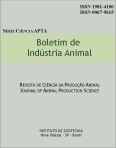Ingestive behavior of Nellore and Bonsmara cattle during the feed efficiency test
Keywords:
beef cattle, behavioral traits, feed efficiencyAbstract
Several studies have reported relationship between eating behavior and performance in feedlot cattle. The evaluation of behavior traits demands high degree of work and trained manpower, therefore, in recent years has been used an automated feed intake measurement system (GrowSafe System ®), that identify and record individual feeding patterns. The aim of this study was to evaluate the relationship between feeding behavior traits and average daily gain in Nellore calves undergoing feed efficiency test. Date from 85 Nelore males was recorded during the feed efficiency test performed in 2012, at Centro APTA Bovinos de Corte, Instituto de Zootecnia, São Paulo State. Were analyzed the behavioral traits: time at feeder (TF), head down duration (HD), representing the time when the animal is actually eating, frequency of visits (FV) and feed rate (FR) calculated as the amount of dry matter (DM) consumed by time at feeder (g.min-1). The ADG was calculated by linear regression of individual weights on days in test. ADG classes were obtained considering the average ADG and standard deviation (SD) being: high ADG (>mean + 1.0 SD), medium ADG (± 1.0 SD from the mean) and low ADG (<mean - 1.0 SD). Data were analyzed using the PROC MIXED procedure (SAS 9.3). The model included animal and residue as random effects and the fixed effects of ADG class (1, 2 and 3) and age at the middle of test as a covariate. Low gain animals remained 21.8% less time of head down than medium or high gain animals (P<0.05). Were observed significant effects of ADG class on FR (P<0.01), high ADG animals consumed more feed per time (g.min-1) than the low and medium ADG animals. No diferences were observed (P>0.05) among ADG classes for FV, indicating that these traits are not related to each other. These results shows that the ADG is related to the agility in eat food and not to the time spent in the bunk or to the number of visits in a range of 24 hours.Downloads
Downloads
Published
Issue
Section
License
Os autores não serão remunerados pela publicação de trabalhos, pois devem abrir mão de seus direitos autorais em favor deste periódico. Por outro lado, os autores ficam autorizados a publicar seus artigos, simultaneamente, em repositórios da instituição de sua origem, desde que citada a fonte da publicação original seja Boletim de Indústria Animal. A revista se reserva o direito de efetuar, nos originais, alterações de ordem normativa, ortográfica e gramatical, com vistas a manter o padrão culto da língua e a credibilidade do veículo. Respeitará, no entanto, o estilo de escrever dos autores. Alterações, correções ou sugestões de ordem conceitual serão encaminhadas aos autores, quando necessário. Nesses casos, os artigos, depois de adequados, deverão ser submetidos a nova apreciação. As opiniões emitidas pelos autores dos artigos são de sua exclusiva responsabilidade. Todo o conteúdo deste periódico, exceto onde está identificado, está licenciado sob a Licença Creative Commons Attribution (CC-BY-NC). A condição BY implica que os licenciados podem copiar, distribuir, exibir e executar a obra e fazer trabalhos derivados com base em que só se dão o autor ou licenciante os créditos na forma especificada por estes. A cláusula NC significa que os licenciados podem copiar, distribuir, exibir e executar a obra e fazer trabalhos derivados com base apenas para fins não comerciais.













